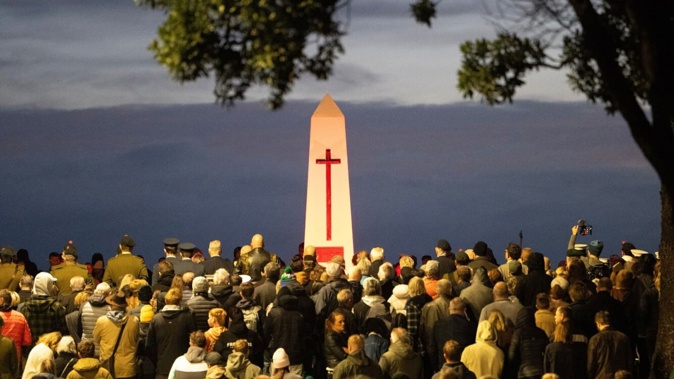
- A large crowd attended the 2025 Anzac dawn service at Mount Maunganui, honouring veterans and service members.
- The Tauranga RSA prepared to merge with the Mount RSA, marking a bittersweet occasion.
- Papamoa’s dawn service, featuring students and the local Turkish community, has grown significantly.
On the cusp of dawn, a large crowd gathered outside the Mount Maunganui cenotaph in Marine Parade for the 2025 Anzac dawn service.
 Warbirds buzz over the Mount Maunganui cenotaph. Photo / David Hall
Warbirds buzz over the Mount Maunganui cenotaph. Photo / David Hall
The crowd received a welcome from Mount RSA president Greg Baxter, who reminded them of what Anzac Day stands for.
“To honour the service and the sacrifice of those who have served our nation.”
 A member of the Western Bay Cadet Unit stands in silence at the dawn service in Mount Maunganui. Photo / David Hall
A member of the Western Bay Cadet Unit stands in silence at the dawn service in Mount Maunganui. Photo / David Hall
A mixture of veterans, service members, cadets and civilians lined the streets, with the crowd stretching on to the bank of Hopukiore Reserve.
Former Warrant Officer Darryn Douglas, now riding with the Patriots motorcycle group of past and present service members, said the day was a chance to reflect on those who died for our country.
 Former Warrant Officer Darryn Douglas. Photo / David Hall
Former Warrant Officer Darryn Douglas. Photo / David Hall
Sentinel guard commander Dusty Roper, of the Western Bay Cadet Unit, was attending his fifth Anzac Day service and had looked forward to leading his group on to the cenotaph grounds.
“We have been practising, practising the drill movers, and practising the sequence and getting everything down.”
 Sentinel guard commander and Western Bay cadet Dusty Roper. Photo / David Hall
Sentinel guard commander and Western Bay cadet Dusty Roper. Photo / David Hall
 A Western Bay cadet acts as a sentinel guard at the cenotaph. Photo / David Hall
A Western Bay cadet acts as a sentinel guard at the cenotaph. Photo / David Hall
At the Tauranga RSA, emotions ran high on a bittersweet day as the branch prepared to merge with the Mount RSA in February.
“It is a sad day,” Tauranga city councillor Marten Rozeboom said.
 Former Tauranga RSA president Captain Fred Milligan.
Former Tauranga RSA president Captain Fred Milligan.
Former president and Royal New Zealand Army Captain Fred Milligan enlisted in 1955 and fondly remembered his time there.
He recalled an officer leaving a driver in his charge who had become “irritating”, when he was a lance corporal.
“He asked, ‘What can I do’? So I told him, ‘go away and paint The Last Post’,” Milligan said.
The man in his charge disappeared for some time before eventually reappearing.
Milligan said it turned out the man had painted all the posts near a live training area.
When he joined the army, it was a class of 30 people.
“Now, there are seven of us left.”
Milligan has witnessed Anzac Days in Australia and New Zealand and placed a wreath at a service in Southport, Queensland.
“I couldn’t believe it. The crowd they got there in Southport was just unbelievable.”
The “evocative” Pāpāmoa dawn service was initially set up to relieve pressure on the dawn service at Hopukiore and has grown larger yearly.
It marked the third anniversary at Pāpāmoa, organiser Buddy Mikaere said.
 Pāpāmoa dawn service organiser Buddy Mikaere. Photo / Andrew Warner
Pāpāmoa dawn service organiser Buddy Mikaere. Photo / Andrew Warner
The dawn service included students from Pāpāmoa College and involved the local Turkish community.
Anzac Day is special for Mikaere because his family has been involved in nearly every major conflict for more than 100 years.
It featured a significant Māori component with the benediction in tereo, accompanying two waitai.
After the dawn service, Mikaere said the Pāpāmoa fire brigade hosted breakfast.
The Last Post and the placing of the wreaths were among the highlights of this year’s dawn service, hosted by the Western Bay of Plenty Regional Council, District Mayor James Denyer said.
“It is important to remember the service and huge sacrifices made on our behalf.”
Anzac Day also allows the mayor to see representatives from all sections of his community come forward to place their wreaths.
“It also gives us a chance to reflect on the suffering that wars create and learn the lessons of the past.”
Denyer attended the dawn service in Katikati and the civic service in Te Puke.
This Anzac Day marked Tauranga Mayor Mahé Drysdale’s first in office, but the occasion has long been a chance for him to reflect and share memories with his family who served.
 Tauranga Mayor Mahé Drysdale addresses the crowd at the civic memorial service at the cenotaph in Memorial Park. Photo / Tom Eley
Tauranga Mayor Mahé Drysdale addresses the crowd at the civic memorial service at the cenotaph in Memorial Park. Photo / Tom Eley
“It’s a chance to remember and honour those who have served and continue to serve our country in theatres of global conflict.”
Drysdale welcomed the crowd to the civic memorial service at the cenotaph in Memorial Park.
“On this day, we remember the event of 25 April 1915. The troops landed and cost the lives of many young soldiers and deeply impacted the families and communities they left behind.”
Tauranga made a significant contribution in both world wars, general manager of community services Barbara Dempsey said.
More than 500 men from Tauranga volunteered during World War I when the city had a population of fewer than 3000 at that time, she explained.
 Royal New Zealand Navy Sub-Lieutenant Alex Eichelbaum. Photo / Tom Eley
Royal New Zealand Navy Sub-Lieutenant Alex Eichelbaum. Photo / Tom Eley
Guest speaker Sub-Lieutenant Alex Eichelbaum, Royal New Zealand Navy, wished 100-year-old John Clark a happy birthday at the civic service.
“John enlisted in the Royal Navy just before his 17th birthday in 1942, becoming a telegraphist on the heavy cruiser HMS Suffolk until 1945.”
 Teenager at war: Royal Navy signalman and telegraphist John Clark, of HMS Suffolk. Photo / Supplied
Teenager at war: Royal Navy signalman and telegraphist John Clark, of HMS Suffolk. Photo / Supplied
“He discharged as leading signalman in April 1946.”
Tauranga MP Sam Uffindell said it was a “very moving day” and a chance to reflect on those who made modern New Zealand possible.
At the Waihī Beach RSA, club manager Mel Gearon said a crowd of over 1000 people turned up to the dawn service.
Gearon said it was important to remember and honour the Australians and New Zealanders who served and died in all wars, conflicts and peacekeeping operations.
“The sacrifices they made should not be forgotten.”
Take your Radio, Podcasts and Music with you









